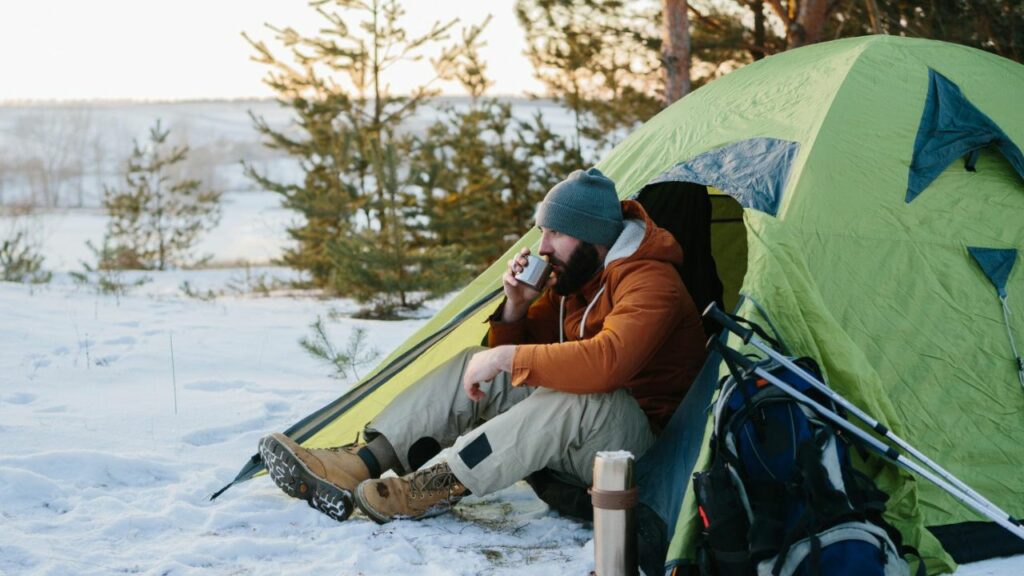We're an affiliate. We hope you love the products we recommend! Just so you know, we may collect a share of sales or other compensation from the links on this page. Thank you if you use our links, we really appreciate it!
Camping in 20-degree weather can be an exhilarating experience, but it’s not for the faint of heart. With temperatures well below freezing, it’s important to be prepared with the right gear and knowledge to stay warm and safe.
Whether you’re an experienced winter camper or a first-timer, we’ve got tips to make your trip enjoyable and comfortable.
With the right preparation and mindset, camping in 20-degree weather can be a truly unforgettable adventure, if a bit of a chilly and challenging one.
Essential Gear for Cold Weather Camping

When camping in 20-degree weather, it’s essential to have the right gear to stay warm and safe. Here are some key items to include on your cold-weather camping gear checklist:
The Right Tent
A suitable tent is crucial for camping in 20-degree weather. A four-season tent or a hot tent with a stove jack are your best bets. These tents are designed to withstand strong winds and heavy snowfall, so you’ll be nice and cozy even if the weather gets intense.
Sleeping Essentials
A warm sleeping bag and sleeping pad are essential to keep you insulated from the cold ground. Look for a sleeping bag that is insulated with down or synthetic materials and has a temperature rating suitable for 20-degree weather.
To prevent the cold from seeping in from underneath, use two pads, a closed-cell foam pad next to the ground and a self-inflating pad on top to get the best insulation. Check the R-value of your sleeping pads to ensure they’re suitable for cold-weather camping.
Appropriate Clothing
Wearing appropriate clothing is crucial for staying warm and dry in 20-degree weather. Like with any cold-weather activity, layering is key, starting with a moisture-wicking base layer, followed by an insulation layer, and topped with a waterproof and windproof outer layer. Look for materials such as merino wool and fleece for insulation and moisture-wicking properties. Don’t forget a warm hat to keep your head and ears covered. Bring extra socks and gloves, including waterproof gloves to keep your hands dry.
Essential Accessories
In addition to the essential gear mentioned above, there are a few additional accessories that are must-haves for a 20-degree camping experience.
Insulated water bottle: In 20-degree weather, you need to think about keeping your water supply from freezing. An insulated water bottle can help keep your water liquid for longer.
Camp stove: In 20-degree weather, you need hot meals. Make sure you have a camp stove designed for cold-weather use. This stove can also be used to thaw water or melt snow if your water supply freezes.
Hot water bottle: Can add warmth to your sleeping area at night.
Map and compass: Things look different covered in snow, so make sure you have a map and compass to help navigate if you get turned around in the woods.
A mylar blanket: To create an emergency shelter or create wind protection around your campsite.

Food and Beverage Considerations
When camping in 20-degree weather, you’ll likely burn more calories and need more food, so it’s important to consider your food and beverage supply carefully. Here are some tips to help you stay well-fed and hydrated during your chilly adventure:
- Bring plenty of high-energy snacks like trail mix, jerky, and granola bars. These foods are easy to pack and can provide a quick boost of energy when you need it most.
- Bring a portable stove or grill (and a back-up). Warm soups, stews, and chili can be especially comforting on a cold day.
- Oatmeal is a great breakfast option for cold weather camping. It’s easy to prepare and can help keep you feeling full and warm throughout the morning.
- Invest in a good thermos to keep your hot beverages warm all day long. Hot cocoa, tea, and coffee can be great options for staying warm and hydrated.
- Don’t forget to drink plenty of water, even if you’re not feeling thirsty. Dehydration can be a serious risk in cold weather, so make sure to stay hydrated throughout the day.
Staying Warm in 20-Degree Weather
When camping in 20-degree weather, staying warm is crucial for your safety and comfort. Here are some tips for staying warm while camping in 20-degree weather.
Layering Technique
One of the most important things you can do to stay warm while camping in 20-degree weather is to layer up. Layering helps to trap warm air close to your body, keeping you warm. Here’s how to layer up:
- Start with a base layer of thermal underwear or long johns.
- Add a mid-layer of fleece or wool to insulate your body.
- Finish with an outer layer of windproof and waterproof jacket and pants.
Maintaining Body Heat
Maintaining your body heat is also important to stay warm while camping in 20-degree weather. Here are some tips to maintain your body heat:
- Stay active to generate body heat. Go for a short hike or do some light exercises.
- Eat high-calorie foods to fuel your body and generate heat.
- Avoid alcohol and caffeine, as they can cause dehydration and lower your body temperature.
Managing Tent Conditions
Your tent is your shelter from the cold, so it’s important to manage the conditions inside your tent. Here are some tips for managing your tent conditions:
- Build a good fire outside your tent to provide heat and light.
- Use wind protection or windbreaks to reduce wind chill.
- Keep your tent well-ventilated to avoid condensation and maintain air quality.
Safety Measures and Precautions

When camping in 20-degree weather, safety priorities shift. Cold weather can pose significant risks to your health, including hypothermia and frostbite, if proper precautions are not taken. It’s important to know how to prevent these dangerous conditions and symptoms to look for while you’re camping.
Hypothermia Awareness
Hypothermia occurs when your body loses heat faster than it can produce it, causing a dangerously low body temperature. Symptoms of hypothermia include shivering, confusion, slurred speech, and loss of coordination. If you or someone in your group shows signs of hypothermia, it’s crucial to take action immediately. Here are some tips to prevent hypothermia:
- Dress in layers to stay warm and dry.
- Keep your head, neck, and hands covered.
- Avoid getting wet or sweaty.
- Stay hydrated and well-fed.
- Stay active to generate body heat.
Frostbite Prevention
Frostbite is a condition that occurs when skin and underlying tissues freeze due to exposure to cold temperatures. It most commonly affects the fingers, toes, nose, and ears. To prevent frostbite, follow these tips:
- Dress in warm, dry clothing and avoid tight-fitting shoes or boots.
- Keep extremities covered with warm gloves or mittens, socks, and hats.
- Avoid touching cold metal objects with bare skin.
- Keep an eye out for signs of frostnip, such as numbness or tingling in your fingers or toes.
- Seek medical attention immediately if you suspect frostbite.
Camping Site Selection
Choosing the right campsite is crucial to staying safe and comfortable in 20-degree weather. Look for a sheltered spot that offers protection from the wind and elements. Avoid setting up camp near bodies of water, as they can create a damp and humid environment that can accelerate heat loss. When building a fire, make sure to pick a suitable location that is away from trees, bushes, and tents to avoid accidental sparks and fire.
Preparing for a 20-Degree Weather Camping Trip
Embarking on a camping trip in 20-degree weather requires careful preparation to ensure not only a memorable experience but a safe one. Here are a final few tips to make sure you plan as well as you can before heading out:
- Research the Location: Before heading out, familiarize yourself with the area where you’ll be camping. Look up the local weather forecast and be aware of any expected changes. Understanding the terrain will also give you an idea of the best spots to set up camp.
- Plan Ahead: It’s essential to notify a trusted person about your camping location and the expected duration of your trip. Should any unforeseen circumstances arise, someone will know where to look for you.
- Packing Checklists: Double-check your gear before leaving. It’s easy to forget a crucial item, so make a comprehensive checklist. This will not only help you ensure you’ve packed everything, but it’ll also aid in not over-packing unnecessary items.
- Physical Preparation: Cold weather can be taxing on the body. A few weeks before your trip, start taking short hikes or engaging in exercises to boost stamina. This preparation will help you adapt more quickly to the physical demands of camping in cold weather.
- Emergency Kit: Pack a separate emergency kit with essential items like a whistle, flashlight, extra batteries, first-aid supplies, and emergency contact information. This kit can be a lifesaver in unexpected situations.
- Stay Flexible: Even with the best plans, nature can be unpredictable. Be prepared to change your plans or even cut your trip short if the weather becomes too severe. Your safety should always be the top priority.
Camping in 20-degree weather can be an awe-inspiring experience, offering serene landscapes and the unique tranquility of winter. But it’s also a challenge that requires thorough preparation and respect for nature’s power. With the right mindset, gear, and planning, you can ensure that your cold-weather camping trip is both safe and unforgettable. Embrace the adventure and let the crisp, cold air rejuvenate your spirit.

We’re passionate about getting the most from your car when it comes to going on adventures and road trips. When you take one of these trips you often need more room in your car than you usually would. This is when we come in, to help you find the best roof tent for your car and needs.

